Numerical Test and Strength Prediction of Concrete Failure Process Based on RVM Algorithm
Abstract
1. Introduction
2. Materials and Methods
2.1. Material
2.2. Mechanical Properties Test
2.3. Construction of Simulation Database Based on Abaqus
3. Construction of Concrete Mechanics Model Based on RVM
3.1. Theory of RVM Method
3.2. Data Set Analysis
3.3. Results and Analysis
4. Conclusions
Author Contributions
Funding
Data Availability Statement
Conflicts of Interest
References
- You, F.; Luo, S.; Zheng, J. Experimental study on residual compressive strength of recycled aggregate concrete under fatigue loading. Front. Mater. 2022, 9, 13. [Google Scholar] [CrossRef]
- Kim, D.K.; Chang, S.K.; Sang, K.C. Advanced Probabilistic Neural Network for the Prediction of Concrete Strength. Icces 2007, 2, 29–34. [Google Scholar] [CrossRef]
- Liu, C.Y.; Wang, Y.; Hu, X.M.; Han, Y.L.; Zhang, X.P.; Du, L.Z. Application of GA-BP neural network optimized by Grey Verhulst model around settlement prediction of foundation pit. Geofluids 2021, 2021, 5595277. [Google Scholar] [CrossRef]
- Lee, J.J.; Kim, D.K.; Chang, S.K.; Lee, J.H. Application of support vector regression for the prediction of concrete strength. Comput. Concr. 2007, 4, 299–316. [Google Scholar] [CrossRef]
- Al-Attar, T. Development of Mathematical Models for Prediction of Structural Concrete Strength. Ph.D. Thesis, College of Engineering, University of Baghdad, Baghdad, Iraq, 2001. [Google Scholar]
- Nguyen, H.; Vu, T.; Vo, T.P.; Thai, H.T. Efficient machine learning models for prediction of concrete strengths. Constr. Build. Mater. 2021, 266, 120950. [Google Scholar] [CrossRef]
- Liu, C.; Du, L.; Zhang, X.; Wang, Y.; Hu, X.; Han, Y. A New Rock Brittleness Evaluation Method Based on the Complete Stress-Strain Curve. Lithosphere 2021, 2021, 4029886. [Google Scholar] [CrossRef]
- Ly, H.B.; Nguyen, M.H.; Pham, B.T. Metaheuristic optimization of Levenberg–Marquardt-based artificial neural network using particle swarm optimization for prediction of foamed concrete compressive strength. Neural Comput. Appl. 2021, 33, 17331–17351. [Google Scholar] [CrossRef]
- Wu, X.; He, Q.; Zheng, P.; Xiao, K.L. Influence Analysis of Concrete Strength on Time-Varying Reliability of Widening T-Beam Bridge Based on Support Vector Method. J. Chongqing Jiaotong Univ. (Nat. Sci.) 2019, 38, 33–38. [Google Scholar]
- Wu, D.-Y. Influence of maintain duration on prediction of concrete strength by rebound method. J. Anhui Inst. Archit. 2005, 5, 8–10. [Google Scholar]
- Zain, M.F.M.; Abd, S.M.; Sopian, K.; Jamil, M.; Che-Ani, A.I. Mathematical regression model for the prediction of concrete strength. In Proceedings of the 10th WSEAS International Conference on Mathematical Methods, Computational Techniques and Intelligent Systems, Sofia, Bulgaria, 2–4 May 2008. [Google Scholar]
- Sharifi, J.; Nikodel, M.R. Prediction of Concrete Strength Containing Different Aggregates through Artificial Neural Networks. J. Eng. Geol. 2015, 9, 2983–3002. [Google Scholar] [CrossRef][Green Version]
- Karaman, K.; Bakhytzhan, A. Prediction of concrete strength from rock properties at the preliminary design stage. Geomech. Eng. 2020, 23, 115–125. [Google Scholar] [CrossRef]
- Shariati, M.; Mafipour, M.S.; Mehrabi, P.; Ahmadi, M.; Wakil, K.; Trung, N.T.; Toghroli, A. Prediction of concrete strength in presence of furnace slag and fly ash using Hybrid ANN-GA (Artificial Neural Network-Genetic Algorithm). Smart Struct. Syst. 2020, 25, 183–195. [Google Scholar] [CrossRef]
- Lin, W.; Bo, Y.; Abraham, A. Prediction of Concrete Strength Using Floating Centroids Method. In Proceedings of the IEEE International Conference on Systems, Manchester, UK, 13–16 October 2013. [Google Scholar] [CrossRef][Green Version]
- Rajasekaran, S.; Lee, S.C. Prediction of concrete strength using serial functional network model. Struct. Eng. Mech. 2003, 16, 83–99. [Google Scholar] [CrossRef]
- Carino, N.J. Prediction of potential concrete strength at later ages. ASTM Spec. Tech. Publ. 1994, 169, 140–152. [Google Scholar]
- Han, C.G.; Joo, E.H. Rapid Evaluation Method for Blast Furnace Slag Fineness and Influence of Fineness on Properties of Cement Mortar. J. Archit. Inst. Korea Struct. Constr. 2018, 34, 13–18. [Google Scholar] [CrossRef]
- Kaloop, M.R.; Roy, B.; Chaurasia, K.; Kim, S.M.; Jang, H.M.; Hu, J.W.; Abdelwahed, B.S. Shear Strength Estimation of Reinforced Concrete Deep Beams Using a Novel Hybrid Metaheuristic Optimized SVR Models. Sustainability 2022, 14, 5238. [Google Scholar] [CrossRef]
- Hong, J.; Miao, C. Study on prediction of concrete strength using wavelet neural network. Ind. Constr. 2004, 34, 47–49. [Google Scholar]
- Uddin, M.N.; Li, L.Z.; Khan, R.K.M.; Shahriar, F.; Sob, L.W.T. Axial Capacity Prediction of Concrete-Filled Steel Tubular Short Members Using Multiple Linear Regression and Artificial Neural Network. Mater. Sci. Forum 2021, 1047, 220–226. [Google Scholar] [CrossRef]
- Wang, X.; Dong, S.; Ashour, A.; Han, B. Bond of nanoinclusions reinforced concrete with old concrete: Strength, reinforcing mechanisms and prediction model. Constr. Build. Mater. 2021, 283, 122741. [Google Scholar] [CrossRef]
- Wang, X.; Liu, Y.; Xin, H. Bond strength prediction of concrete-encased steel structures using hybrid machine learning method. Structures 2021, 32, 2279–2292. [Google Scholar] [CrossRef]
- Assis, L.S.D.; Assis, J.T.D.; Pessoa, J.R.D.C.; Tavares Júnior, A.D. Elaboration of fracture prediction map using 2D digital image correlation—2D CID. Rev. IBRACON Estrut. Mater. 2022, 15, 1–9. [Google Scholar] [CrossRef]
- Razzaghi, H.; Madandoust, R.; Aghabarati, H. Point-load test and UPV for compressive strength prediction of recycled coarse aggregate concrete via generalized GMDH-class neural network. Constr. Build. Mater. 2021, 276, 122143. [Google Scholar] [CrossRef]
- Zhu, L.; Zhao, C.; Dai, J. Prediction of compressive strength of recycled aggregate concrete based on gray correlation analysis. Constr. Build. Mater. 2021, 273, 121750. [Google Scholar] [CrossRef]
- Zulkarnain, M.; Mukhtar, Z.Z.; Khosim, N.M.; Ramadhansyah, P.J.; Adiyanto, M.I.; Haziman, W.M. Prediction of Flexural Behavior of Woven Reinforced for Concrete Reinforcement. In IOP Conference Series: Earth and Environmental Science; IOP Publishing: Bristol, UK, 2021; Volume 682, p. 12052. [Google Scholar]
- Kumar, A.; Arora, H.C.; Kumar, K.; Mohammed, M.A.; Majumdar, A.; Khamaksorn, A.; Thinnukool, O. Prediction of FRCM–Concrete Bond Strength with Machine Learning Approach. Sustainability 2022, 14, 845. [Google Scholar] [CrossRef]
- Zhang, X.; Akber, M.Z.; Zheng, W. Prediction of seven-day compressive strength of field concrete. Constr. Build. Mater. 2021, 305, 124604. [Google Scholar] [CrossRef]
- Niu, Y.; Cheng, H.; Wu, S.; Sun, J.; Wang, J. Rheological Properties of Cemented Paste Backfill and the Construction of a Prediction Model. Case Stud. Constr. Mater. 2022, 16, e01140. [Google Scholar] [CrossRef]
- Congro, M.; de Alencar Monteiro, V.M.; Brandão, A.L.; dos Santos, B.F.; Roehl, D.; de Andrade Silva, F. Prediction of the residual flexural strength of fiber reinforced concrete using artificial neural networks. Constr. Build. Mater. 2021, 303, 124502. [Google Scholar] [CrossRef]
- Sabapathy, Y.K.; Sabarish, S.; Nithish, C.N.A.; Ramasamy, S.M.; Krishna, G. Experimental study on strength properties of aluminium fibre reinforced concrete. J. King Saud Univ.-Eng. Sci. 2021, 33, 23–29. [Google Scholar] [CrossRef]
- Kovačević, M.; Lozančić, S.; Nyarko, E.K.; Hadzima-Nyarko, M. Application of Artificial Intelligence Methods for Predicting the Compressive Strength of Self-compacting Concrete with Class F Fly Ash. Materials 2022, 15, 4191. [Google Scholar] [CrossRef]
- Vincentdospital, T.; Toussaint, R.; Cochard, A. Thermal dissipation as both the strength and weakness of matter. A material failure prediction by monitoring creep. Soft Matter 2021, 17, 4143–4150. [Google Scholar]
- Lyngdoh, G.A.; Zaki, M.; Krishnan, N.A.; Das, S. Prediction of concrete strengths enabled by missing data imputation and interpretable machine learning. Cem. Concr. Compos. 2022, 128, 104414. [Google Scholar] [CrossRef]

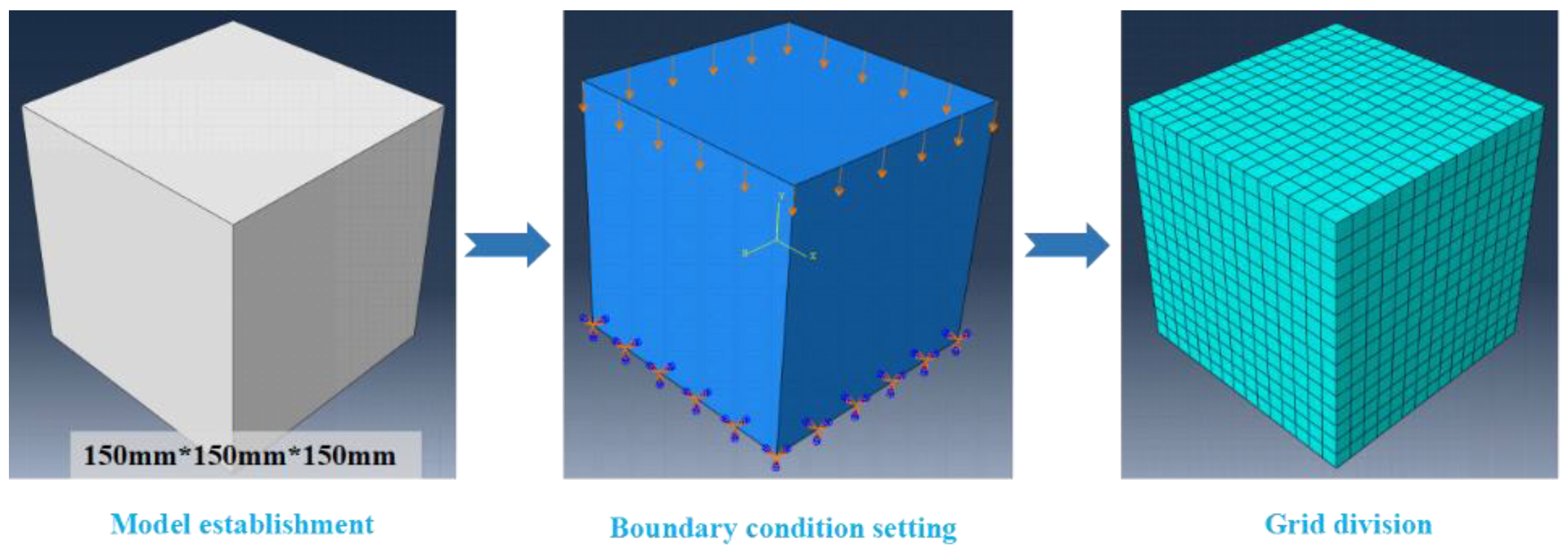
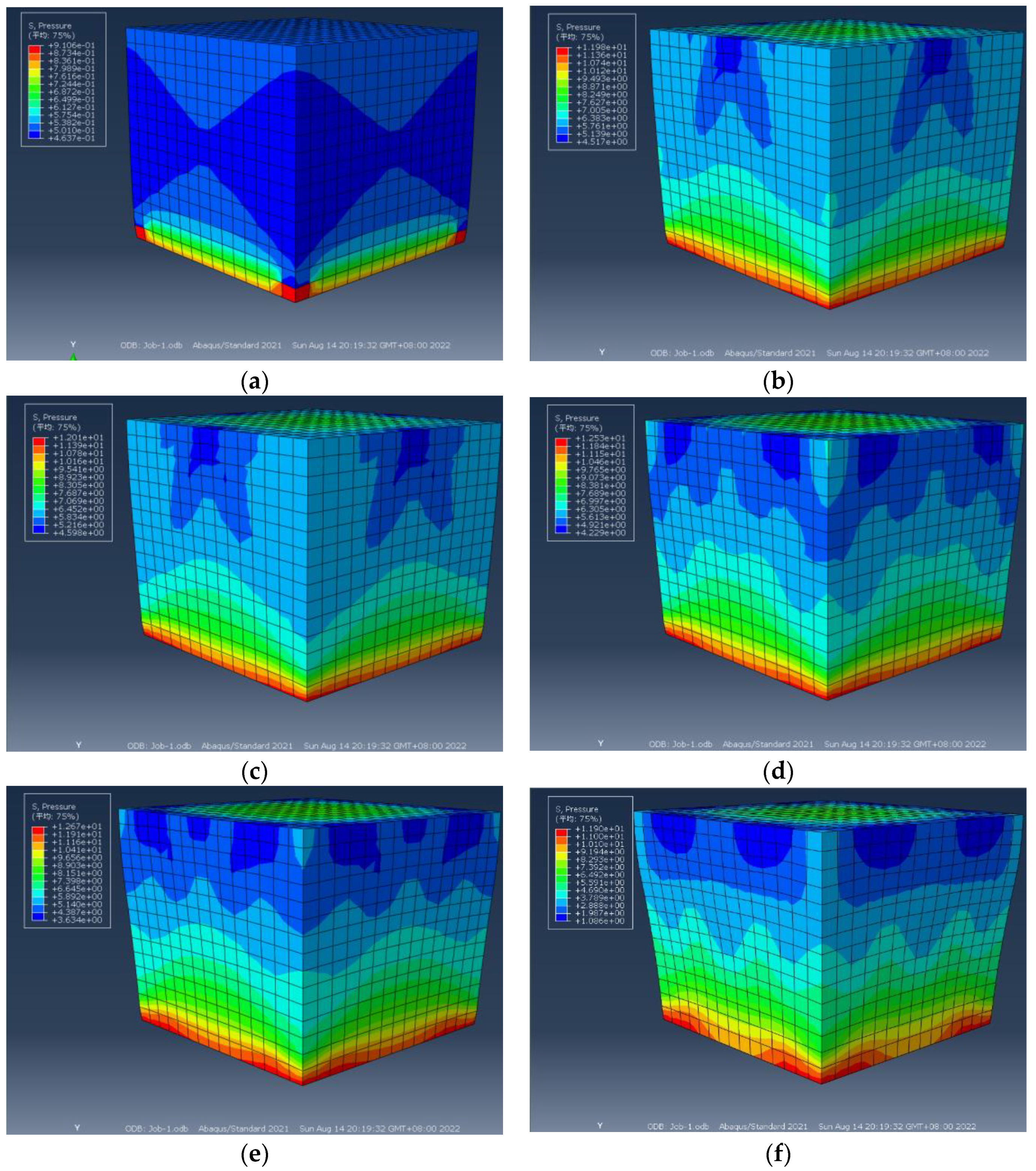
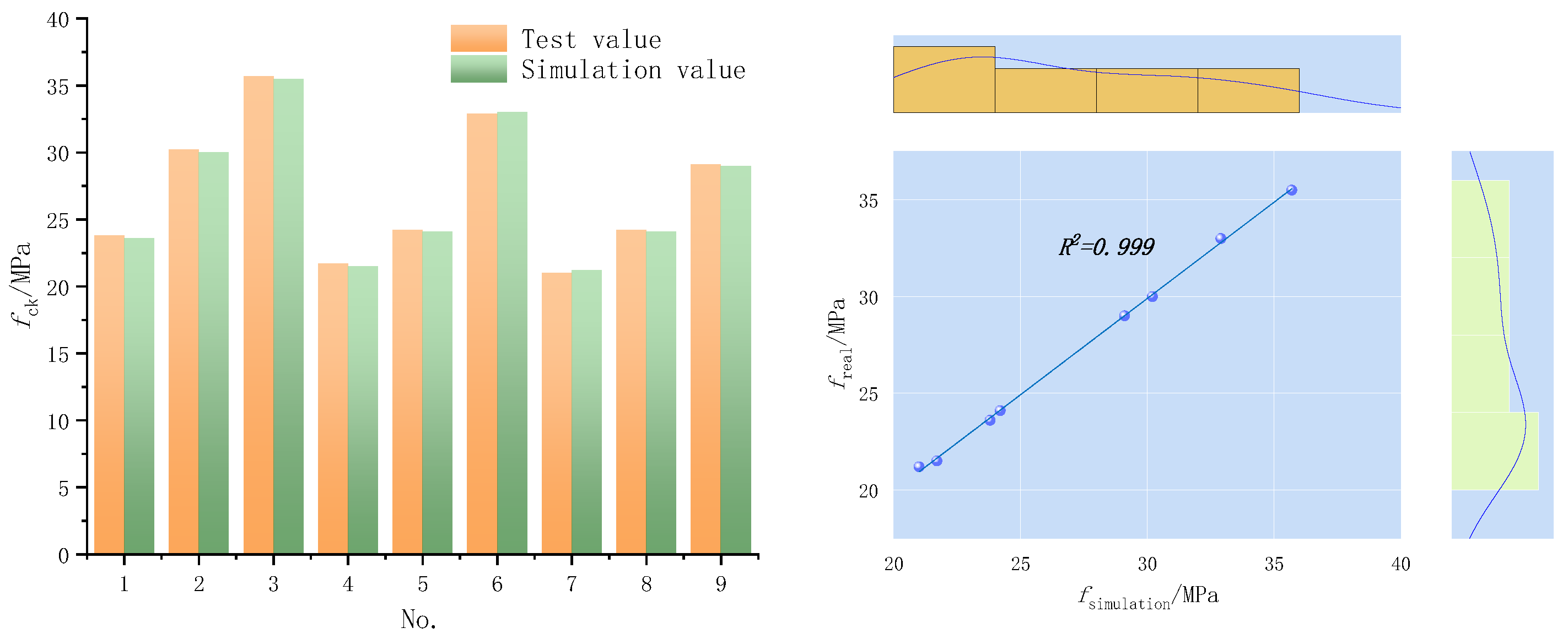


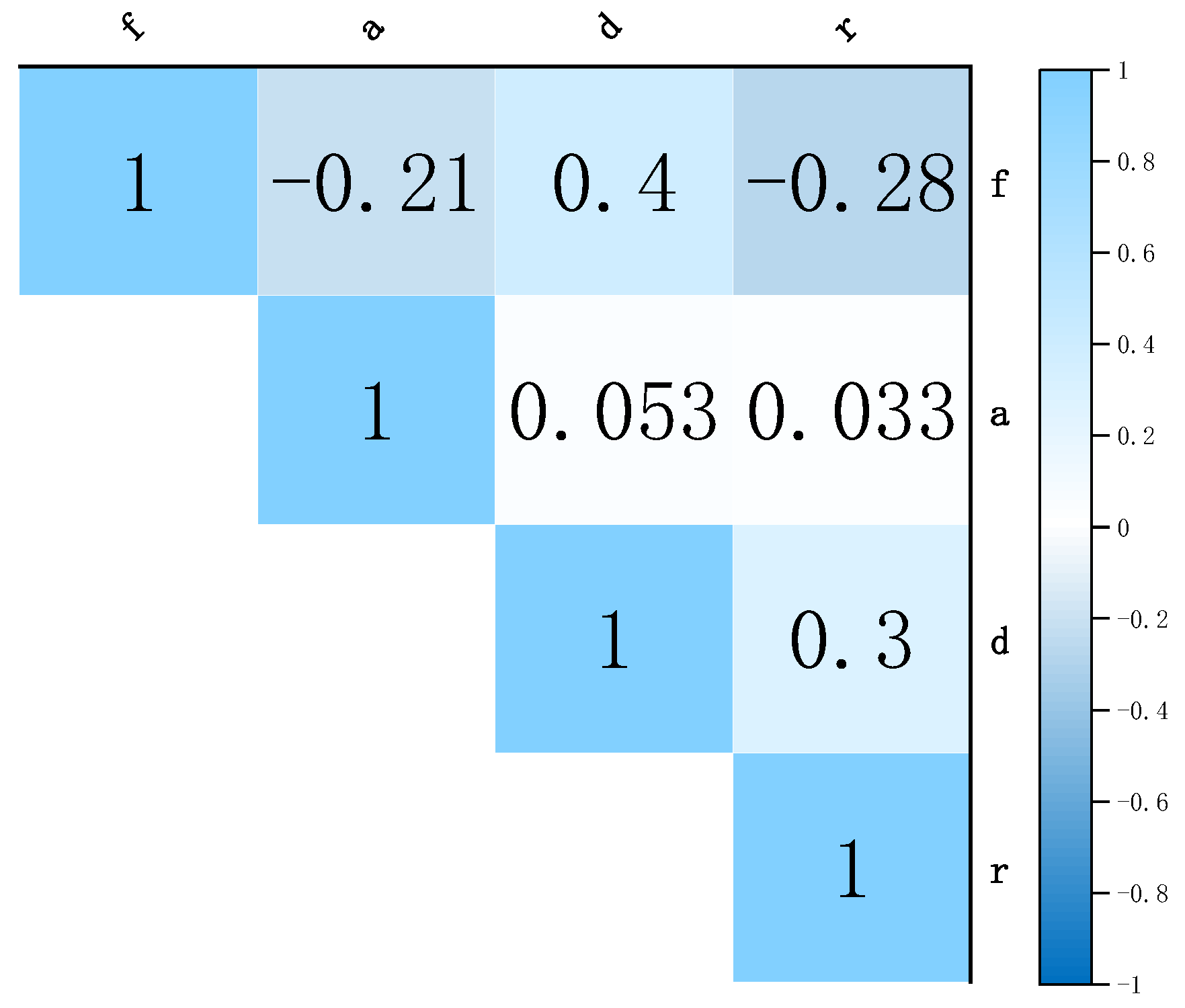
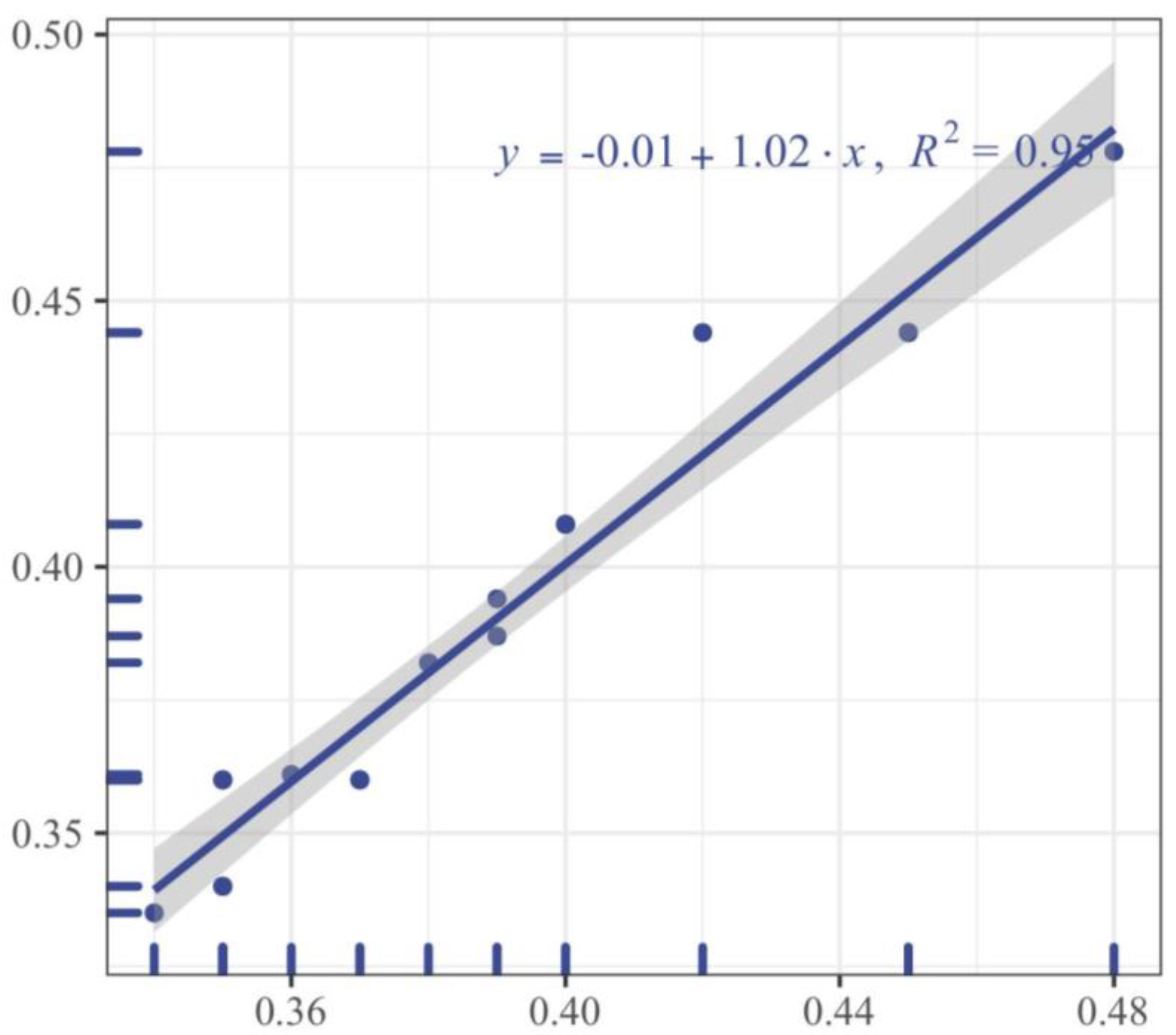
| Category | Burning Vector/% | w(MgO)/% | w(SO3)/% | Initial Setting Time/min | Final Coagulation Time/min |
|---|---|---|---|---|---|
| Content | 3.4 | 2.65 | 3.0 | 95 | 550 |
| No. | a | d | r | fck/MPa |
|---|---|---|---|---|
| 1 | 0.43 | 3 | 0.43 | 23.8 |
| 2 | 0.43 | 7 | 0.43 | 30.2 |
| 3 | 0.43 | 28 | 0.43 | 35.7 |
| 4 | 0.49 | 3 | 0.43 | 21.7 |
| 5 | 0.49 | 7 | 0.43 | 24.2 |
| 6 | 0.49 | 28 | 0.43 | 32.9 |
| 7 | 0.55 | 3 | 0.43 | 21.0 |
| 8 | 0.55 | 7 | 0.43 | 24.2 |
| 9 | 0.55 | 28 | 0.43 | 29.1 |
| No. | a | d | r | fck |
|---|---|---|---|---|
| 1 | 0.2 | 3 | 0.38 | 0.35 |
| 2 | 0.2 | 7 | 0.38 | 0.50 |
| 3 | 0.2 | 28 | 0.38 | 0.65 |
| 4 | 0.5 | 3 | 0.38 | 0.26 |
| 5 | 0.5 | 7 | 0.38 | 0.43 |
| 6 | 0.5 | 28 | 0.38 | 0.58 |
| 7 | 0.8 | 3 | 0.38 | 0.24 |
| 8 | 0.8 | 7 | 0.38 | 0.31 |
| 9 | 0.8 | 28 | 0.38 | 0.54 |
| 10 | 0.2 | 3 | 0.50 | 0.39 |
| 11 | 0.2 | 7 | 0.50 | 0.53 |
| 12 | 0.2 | 28 | 0.50 | 0.69 |
| 13 | 0.5 | 3 | 0.50 | 0.42 |
| 14 | 0.5 | 7 | 0.50 | 0.55 |
| 15 | 0.5 | 28 | 0.50 | 0.71 |
| 16 | 0.8 | 3 | 0.50 | 0.29 |
| 17 | 0.8 | 7 | 0.50 | 0.37 |
| 18 | 0.8 | 28 | 0.50 | 0.63 |
| 19 | 0.2 | 3 | 0.62 | 0.27 |
| 20 | 0.2 | 7 | 0.62 | 0.39 |
| 21 | 0.2 | 28 | 0.62 | 0.51 |
| 22 | 0.5 | 3 | 0.62 | 0.23 |
| 23 | 0.5 | 7 | 0.62 | 0.32 |
| 24 | 0.5 | 28 | 0.62 | 0.50 |
| 25 | 0.8 | 3 | 0.62 | 0.20 |
| 26 | 0.8 | 7 | 0.62 | 0.25 |
| 27 | 0.8 | 28 | 0.62 | 0.46 |
| 28 | 0.2 | 3 | 0.20 | 0.45 |
| 29 | 0.2 | 7 | 0.35 | 0.40 |
| 30 | 0.3 | 28 | 0.80 | 0.21 |
| 31 | 0.2 | 3 | 0.20 | 0.80 |
| 32 | 0.2 | 7 | 0.35 | 0.79 |
| 33 | 0.3 | 28 | 0.80 | 0.62 |
| 34 | 0.2 | 3 | 0.20 | 0.45 |
| 35 | 0.2 | 7 | 0.38 | 0.40 |
| 36 | 0.2 | 28 | 0.50 | 0.35 |
| 37 | 0.2 | 3 | 0.62 | 0.37 |
| 38 | 0.2 | 7 | 0.80 | 0.35 |
| 39 | 0.2 | 7 | 0.35 | 0.45 |
| 40 | 0.2 | 28 | 0.80 | 0.40 |
| 41 | 0.3 | 3 | 0.20 | 0.35 |
| 42 | 0.2 | 7 | 0.38 | 0.37 |
| 43 | 0.2 | 28 | 0.50 | 0.35 |
| 44 | 0.2 | 3 | 0.62 | 0.36 |
| 45 | 0.2 | 7 | 0.80 | 0.39 |
| Variable Name | Skewness | Kurtosis | S-W Test |
|---|---|---|---|
| a | 0.595 | 0.758 (0.000) *** | 0.35 |
| d | 0.748 | 0.683 (0.000) *** | 0.50 |
| r | 0.11 | 0.926 (0.015) ** | 0.65 |
| f | −0.041 | 0.952 (0.101) | 0.39 |
| No. | Simulation-fck | RVM Prediction-fck | Errorl |
|---|---|---|---|
| 34 | 0.45 | 0.444 | 0.006 |
| 35 | 0.40 | 0.408 | 0.008 |
| 36 | 0.35 | 0.340 | 0.010 |
| 37 | 0.37 | 0.360 | 0.010 |
| 38 | 0.35 | 0.360 | 0.010 |
| 39 | 0.45 | 0.444 | 0.006 |
| 40 | 0.40 | 0.408 | 0.008 |
| 41 | 0.35 | 0.340 | 0.010 |
| 42 | 0.37 | 0.360 | 0.010 |
| 43 | 0.35 | 0.360 | 0.010 |
| 44 | 0.36 | 0.361 | 0.001 |
| 45 | 0.39 | 0.387 | 0.003 |
| Model | No. | Test | |||
|---|---|---|---|---|---|
| R2 | RMSE | SD | MAPE | ||
| RVM | 34~45 | 0.9506 | 0.0074 | 0.5779 | 1.53% |
Publisher’s Note: MDPI stays neutral with regard to jurisdictional claims in published maps and institutional affiliations. |
© 2022 by the authors. Licensee MDPI, Basel, Switzerland. This article is an open access article distributed under the terms and conditions of the Creative Commons Attribution (CC BY) license (https://creativecommons.org/licenses/by/4.0/).
Share and Cite
Xia, C.; Guo, X.; Dai, W. Numerical Test and Strength Prediction of Concrete Failure Process Based on RVM Algorithm. Buildings 2022, 12, 2105. https://doi.org/10.3390/buildings12122105
Xia C, Guo X, Dai W. Numerical Test and Strength Prediction of Concrete Failure Process Based on RVM Algorithm. Buildings. 2022; 12(12):2105. https://doi.org/10.3390/buildings12122105
Chicago/Turabian StyleXia, Chunyang, Xuedong Guo, and Wenting Dai. 2022. "Numerical Test and Strength Prediction of Concrete Failure Process Based on RVM Algorithm" Buildings 12, no. 12: 2105. https://doi.org/10.3390/buildings12122105
APA StyleXia, C., Guo, X., & Dai, W. (2022). Numerical Test and Strength Prediction of Concrete Failure Process Based on RVM Algorithm. Buildings, 12(12), 2105. https://doi.org/10.3390/buildings12122105










